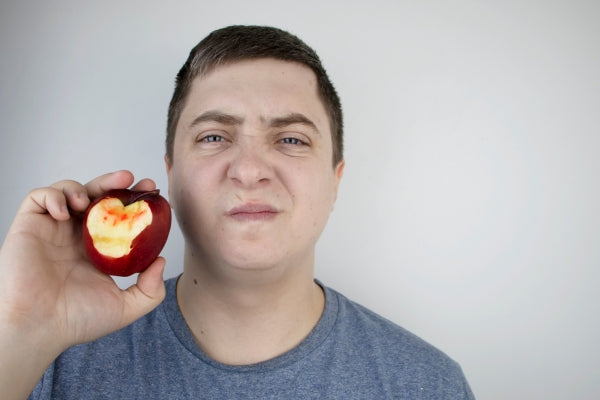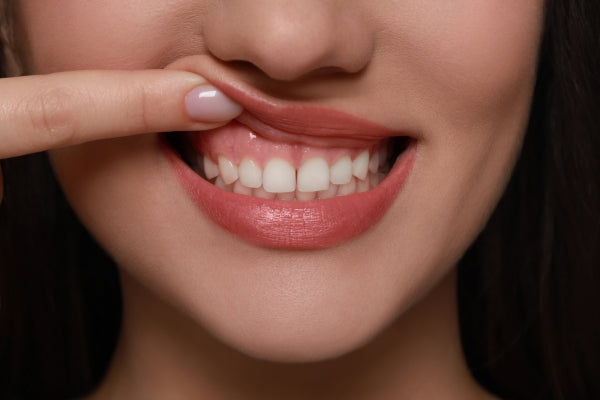
Table of contents
-
Understanding Bleeding Gums
-
Causes of Bleeding Gums
-
Gum Disease (Gingivitis and Periodontitis)
-
Poor Oral Hygiene
-
Hormonal Changes
-
Medications
-
Vitamin Deficiencies
-
Dry Mouth
-
Smoking and Tobacco Use
-
Treating Bleeding Gums
-
Preventing Bleeding Gums
-
Brush Your Teeth Twice Daily
-
Floss Daily
-
Regular Dental Checkups
-
Eat a Healthy Diet
-
Quit Smoking
-
Manage Stress
-
Straightening Your Smile with Confidence: How Aligner32 Can Help
-
How to Maintain Aligners and Braces
-
FAQs
Gum health is necessary for a smile that looks good. They provide a strong foundation for your teeth and act as a barrier against infection. That being said, if you see bleeding while you brush or floss your gums, it's not a good sign to ignore. Gum bleeding could be a sign of gum disease, which can have serious health consequences if left untreated.
This blog will cover the reasons, treatments, and crucial tips for preventing bleeding gums from happening again. We'll also go over the importance of maintaining oral health and touch on several quick alternatives to straightening teeth.
Understanding Bleeding Gums

Bleeding gums, also known as gingival bleeding, are a common dental issue. While occasional bleeding gums might not be a cause for immediate concern, frequent bleeding can indicate a problem with your gum health.
Causes of Bleeding Gums
Several factors can contribute to bleeding gums. Here are some of the most common culprits:
Gum Disease (Gingivitis and Periodontitis)
This is the leading cause of bleeding gums. Plaque, a sticky film of bacteria that forms on teeth, is the main culprit. When plaque isn't removed regularly, it hardens into tartar (calculus), which irritates the gums and causes inflammation. If left untreated, gingivitis (the early stage of gum disease) can progress to periodontitis, a severe gum infection that damages the gums and bone supporting your teeth.
Poor Oral Hygiene
Brushing your teeth twice a day and flossing daily is crucial for removing plaque and preventing gum disease. If you're not cleaning your teeth effectively, bleeding gums are a likely consequence.
Hormonal Changes
Pregnancy, menstruation, and puberty can cause fluctuations in hormone levels, making gums more sensitive and prone to bleeding.
Medications
Certain medications, such as blood thinners and some birth control pills, can increase the risk of bleeding gums.
Vitamin Deficiencies
Deficiencies in vitamin C and K can contribute to weak gums and bleeding.
Dry Mouth
A dry mouth can make it harder for your mouth to fight off bacteria, leading to gum inflammation and bleeding.
Smoking and Tobacco Use
Smoking and chewing tobacco weaken the immune system and decrease blood flow to the gums, increasing the risk of gum disease and bleeding gums.
Treating Bleeding Gums
The treatment for bleeding gums depends on the underlying cause. Here are some common approaches:
Improved Oral Hygiene

This is the foundation of treatment for most cases of bleeding gums. Your dentist will recommend a proper brushing and flossing technique to ensure you're effectively removing plaque and bacteria.
Professional Dental Cleaning
A dental hygienist will perform a deep cleaning, which removes tartar buildup and plaque from below the gum line. This can help reduce inflammation and promote gum healing.
Antibiotics
In some cases, your dentist may prescribe antibiotics to fight off bacterial infections in the gums.
Surgery
In severe cases of periodontitis, surgery may be necessary to remove deep pockets of infection and restore supportive bone tissue.
Preventing Bleeding Gums
The good news is that bleeding gums are largely preventable with a good oral hygiene routine. Here are some key steps to take:
Brush Your Teeth Twice Daily
Use a soft-bristled toothbrush and fluoride toothpaste to brush your teeth for two minutes at least twice a day. Focus on the gum line and all surfaces of your teeth.
Floss Daily
Flossing removes plaque and food particles from between your teeth, where brushing can't reach. Aim to floss at least once a day, preferably before bedtime.
Regular Dental Checkups
Schedule regular dental checkups and cleanings with your dentist, typically every six months. This allows for early detection and treatment of gum disease and other oral health problems.
Eat a Healthy Diet
A balanced diet rich in fruits, vegetables, and whole grains provides your body with the nutrients it needs for healthy gums.
Quit Smoking
Smoking is a major risk factor for gum disease and bleeding gums. If you smoke, quitting is one of the best things you can do for your overall health, including your gums.
Manage Stress
Chronic stress can contribute to gum inflammation. Find healthy ways to manage stress, such as exercise, yoga, or meditation.
Straightening Your Smile with Confidence: How Aligner32 Can Help

Beyond preventing bleeding gums, maintaining good oral health also contributes to a confident smile. If you're considering straightening your teeth, at-home clear aligner therapy might be a suitable option for you.
Aligner32 is an innovative brand offering affordable clear aligners that gradually shift your teeth into their desired positions. This treatment method allows for a straighter smile without the need for traditional metal braces.
Here's why Aligner32 could be the perfect solution for achieving your dream smile:
Convenience and Comfort
Unlike traditional braces, clear aligners are removable, making brushing, flossing, and maintaining good oral hygiene easier. This reduces the risk of developing bleeding gums during treatment.
Discreet Treatment
Clear aligners are virtually invisible, allowing you to straighten your teeth without feeling self-conscious.
Affordable Option
Aligner32 offers clear aligners at a competitive price compared to traditional braces.
Easy Process
Aligner32 provides a user-friendly experience. You can start by getting a convenient impression kit at home. This kit allows you to take impressions of your teeth, which are then sent to Aligner32 for a free assessment. Following the assessment, Aligner32 will create a personalized treatment plan if you're a suitable candidate.
Taking the Next Step with Aligner32
If you're interested in learning more about how Aligner32 can help you achieve a straighter smile and improve your overall oral health, here's what you can do:
Visit the Aligner32 website
They have a wealth of information about clear aligner therapy, the treatment process, and pricing.
Order an impression kit
This easy at-home kit allows you to get started on your journey to a straighter smile.
Contact Aligner32 customer support
Their friendly team is happy to answer any questions you may have about clear aligner therapy and whether it's the right option for you.
Remember, a healthy smile is a confident smile. By prioritizing good oral hygiene, addressing bleeding gums, and considering teeth straightening options like Aligner32, you can invest in your oral health and well-being for years to come.
FAQs
1. I occasionally notice blood when I brush my teeth. Should I be worried?
Not necessarily. Occasional bleeding might be due to brushing too hard or gums adjusting to a new flossing routine. However, persistent bleeding could indicate gum disease and requires a visit to your dentist.
2. What are some signs of gum disease beyond bleeding gums?
Red, swollen, or tender gums, persistent bad breath, receding gums, and loose teeth are all potential signs of gum disease.
3. How can I treat bleeding gums at home?
Practice gentle brushing and flossing twice a day. Use a warm saltwater rinse to soothe irritated gums. Consider switching to a soft-bristled toothbrush. However, if bleeding persists, see your dentist for proper diagnosis and treatment.
4. What are some ways to prevent bleeding gums in the future?
Maintain a consistent oral hygiene routine with thorough brushing and flossing. Visit your dentist for regular checkups and cleanings. Eat a balanced diet and consider quitting smoking if you do.
5. Is there anything I can do to strengthen my gums?
A healthy diet rich in vitamins C and K can contribute to gum health. Consider including fruits, vegetables, and whole grains in your meals.